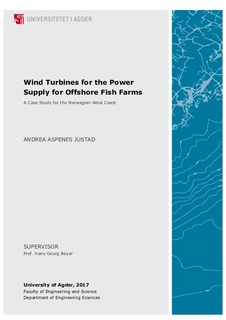| dc.description.abstract | In this thesis the power consumption of a fish farm is set in relation to the expected power
production from a wind turbine in order to assess the feasibility of this combination. The fish
farm, called Rataren, is located in Sør-Trøndelag and hourly data on power consumption is
available in the period 1st February 2016 until 31st August 2016, as a result of change in
energy source from diesel generators to the onshore power grid. This is one of Norway’s
largest fish farms and has 14 cages during the studied period. There are some minor data
losses that are removed from the data sets. Wind speed, air and water temperatures at 2.5 masl
and 1 mbsl are measured by a Seawatch Midi 185 Buoy at the location, and the data are
supplied by SINTEF Ocean. In view of the estimation of the power output of a wind turbine
the data on wind speed have to be extrapolated from measuring height to turbine hub height.
For this the atmospheric stability, estimated here by the temperature difference between the
air and the sea, is taken into account. The classifications used are unstable, slightly unstable,
near-neutral, slightly stable and stable, and are characterized by limits of the temperature
differences set to -3°C, -1°C, 1°C and 3°C.
Two methods of extrapolating wind speed from measuring height to hub height are
considered; the logarithmic law with corrections according to stability and the power law
parametrized according to stability. For both methods the complete calculation of key
variables requires information that is unavailable in this case of study. The problems faced
when using the log law were the determination of stability parameter z/L, but also variation in
friction velocity or roughness height. When using the log law in combination with different
values for the variables based on literature, there were inconsistencies in the results indicated
by unreasonable wind profiles. The more simplified method, the power law, is therefore
concluded as the best approximation when this many parameters are unknown. The power law
exponents that are used to correspond to each of the atmospheric conditions mentioned are set
to 0.07, 0.09, 0.11, 0.13 and 0.15. Hourly mean wind speeds were then calculated using the
power law with the exponent for the stability class found to occur at that particular hour. The
results show an average wind speed of 7.04 m/s at 65 meters, compared to a measured
average of 5.01 m/s at 2.5 meters height.
The hourly power production at site by a Hywind Demo 2.3 MW turbine and a GWP 750 kW
turbine was estimated. To analyse the sensitivity of the results to the relation of consumption
and production, the hourly consumption is also multiplied by three and by six in two other
cases, while being compared to the power production by the Hywind turbine. The production
by a wind farm of three GWP turbines are estimated and compared to the other cases, which
is similar in capacity to the one Hywind turbine. The 750 kW turbines are considered to be
slightly more favourable, as the ratio of energy import to export to the onshore power grid is
lower. In all, the results show that wind turbine is not suitable without energy storage or
additional power sources. Hence, it is not possible to make a firm conclusion of which turbine
is most suitable without further investigations. | nb_NO |

